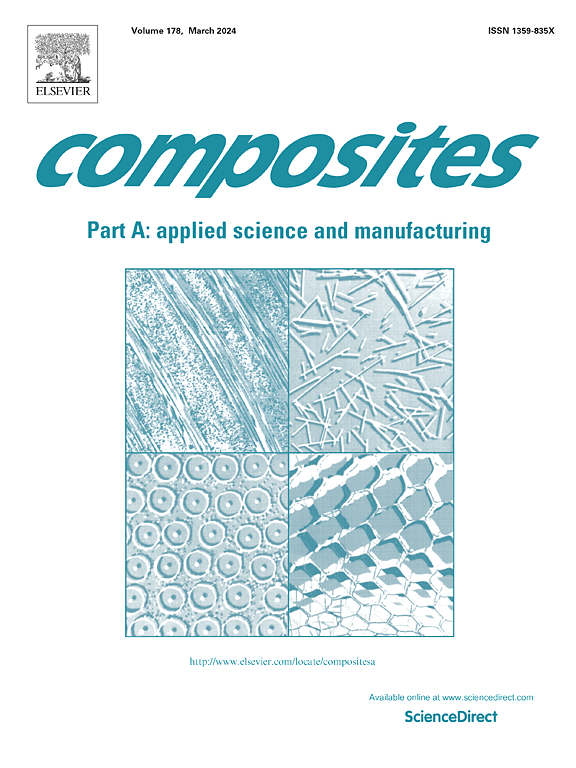A novel phosphinate-decorated montmorillonite nano-micro hybrid for enhanced flame retardancy and mechanical properties of epoxy resin
IF 8.1
2区 材料科学
Q1 ENGINEERING, MANUFACTURING
Composites Part A: Applied Science and Manufacturing
Pub Date : 2025-05-06
DOI:10.1016/j.compositesa.2025.109016
引用次数: 0
Abstract
There is a pressing need to develop epoxy resin (EP) composites that can achieve a harmonious balance between safety performance (fire resistance) and service performance (including mechanical, thermal, and dielectric properties). To address the challenge for balanced safety concerns (fire safety in particular) and service performance in EP composites, a novel organic-inorganic hybrid flame retardant, named OMMT@BIEPA-Al, was designed and prepared through an in-situ growth of aluminum alkylphosphinate with reactive benzimidazole groups on organic-modified montmorillonite (OMMT), enhancing its dispersion in EP. At 5 wt% loading, the EP composite achieves the UL-94 V-0 rating with a Limiting Oxygen Index (LOI) value of 28.8%. Cone calorimetry shows reductions of 41.6% in peak heat release rate (PHRR), 23.4% in total heat release (THR), and 21.6% in total smoke production (TSP). The mechanical properties demonstrate great improvement, most notably a 165.3% increase in impact strength. The dielectric properties are also ameliorated, with the dielectric constant dropping to 3.85 at 1 MHz. This work highlights the substantial potential of the OMMT@BIEPA-Al hybrid in simultaneously enhancing the flame retardancy, mechanical, thermal, and dielectric attributes of EP, thereby opening up promising avenues for the development of high-performance EP composites.

一种新型磷酸盐修饰蒙脱土纳米微杂化物,用于增强环氧树脂的阻燃性和力学性能
迫切需要开发能够在安全性能(防火性能)和使用性能(包括机械、热学和介电性能)之间实现和谐平衡的环氧树脂(EP)复合材料。为了解决EP复合材料在安全性(特别是防火安全性)和使用性能之间的平衡问题,设计并制备了一种新型的有机-无机杂化阻燃剂OMMT@BIEPA-Al,该阻燃剂是通过在有机改性蒙脱土(OMMT)上原位生长具有活性苯并咪唑基团的烷基膦酸铝来增强其在EP中的分散。在5 wt%负载下,EP复合材料达到UL-94 V-0额定值,极限氧指数(LOI)值为28.8%。锥量热法显示,峰值放热率(PHRR)降低了41.6%,总放热率(THR)降低了23.4%,总产烟率(TSP)降低了21.6%。力学性能有较大改善,冲击强度提高165.3%。介质性能也得到改善,在1 MHz时介电常数降至3.85。这项工作突出了OMMT@BIEPA-Al混合材料在同时增强EP的阻燃性、机械性能、热学性能和介电性能方面的巨大潜力,从而为高性能EP复合材料的开发开辟了有前途的道路。
本文章由计算机程序翻译,如有差异,请以英文原文为准。
求助全文
约1分钟内获得全文
求助全文
来源期刊

Composites Part A: Applied Science and Manufacturing
工程技术-材料科学:复合
CiteScore
15.20
自引率
5.70%
发文量
492
审稿时长
30 days
期刊介绍:
Composites Part A: Applied Science and Manufacturing is a comprehensive journal that publishes original research papers, review articles, case studies, short communications, and letters covering various aspects of composite materials science and technology. This includes fibrous and particulate reinforcements in polymeric, metallic, and ceramic matrices, as well as 'natural' composites like wood and biological materials. The journal addresses topics such as properties, design, and manufacture of reinforcing fibers and particles, novel architectures and concepts, multifunctional composites, advancements in fabrication and processing, manufacturing science, process modeling, experimental mechanics, microstructural characterization, interfaces, prediction and measurement of mechanical, physical, and chemical behavior, and performance in service. Additionally, articles on economic and commercial aspects, design, and case studies are welcomed. All submissions undergo rigorous peer review to ensure they contribute significantly and innovatively, maintaining high standards for content and presentation. The editorial team aims to expedite the review process for prompt publication.
 求助内容:
求助内容: 应助结果提醒方式:
应助结果提醒方式:


